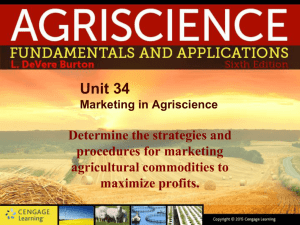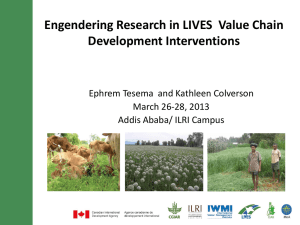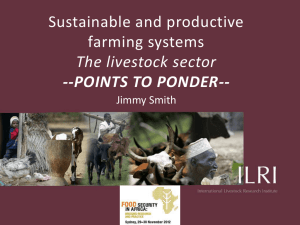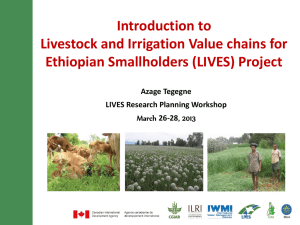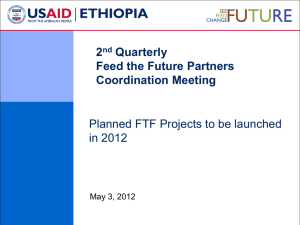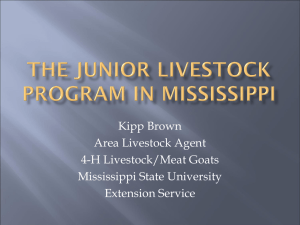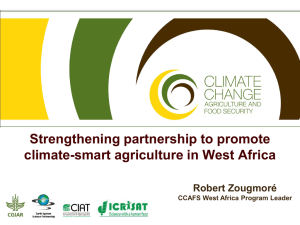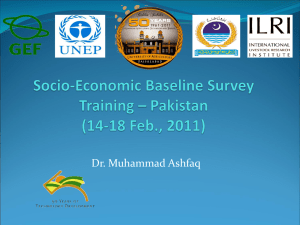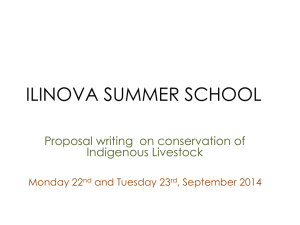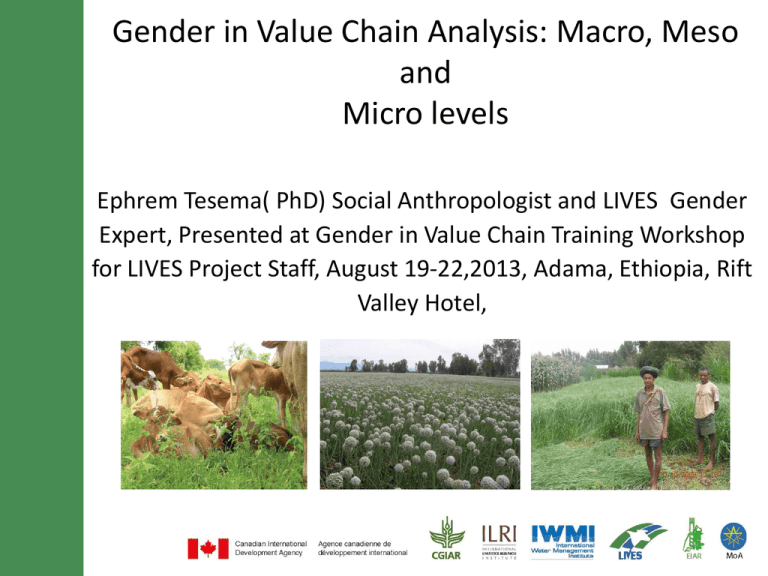
Gender in Value Chain Analysis: Macro, Meso
and
Micro levels
Ephrem Tesema( PhD) Social Anthropologist and LIVES Gender
Expert, Presented at Gender in Value Chain Training Workshop
for LIVES Project Staff, August 19-22,2013, Adama, Ethiopia, Rift
Valley Hotel,
Outline
• Value Chain Analysis with a gender lens
• Data Collection at Macro, Meso and Micro
Levels
• Gender Sensitive Value Chain Mapping
• Analyzing Gender Sensitive Value Chain
Mapping
• Analyzing Gender Based Constraints
• Concluding Remarks
Value Chain Analysis with a gender lens
• Use gender-based Constraints tools to:
Distinguish areas of gender inequalities relevant to
the efficient operation of the VCs
Identify inequalities and the subsequent Factors
Formulate actions to build a VC with equal gender
opportunities
Diagnose the possible Socio-economic realities that
affect gender relations across value chain nodes
Points of Emphasis:
The Value chain governance is the most important
arena in terms of securing equal benefits
VC Mapping at Macro, Meso and Micro Levels
• The Preliminary Mapping shed light on
Institutions, Organizations and Individual actors
involved in a VC
Level of Awareness on gender Equality Issues
The Ones who advocates on Gender inequality
issues
Interaction and linkage among them
Actors with the potential to bring impact on gender
equality
Financial and technical resources committed for
gender equality
Gender Sensitive Value Chain Mapping
Macro Level Analysis
• Cultural Setting/Dynamics
• Regulations and Legislations
Meso Level Analysis
• Gender Sensitivity of specific Local Structures
• Focuses on Institutions and Structures and their
delivery system
• Investigate if they reflect gender equality
principles in their structure, culture, in the
service they provide ( Producers group, BDS etc.
Gender Sensitive Value Chain Mapping Contin’d
Micro Level Analysis
• Identifies major Constraints faced by women at
the HH level
• It shows the repercussion of the constraints on
the meso and macro level specific to
achievements and chain governance
Example IFPRI/ILRI Mapping of Assets within the HH
Natural
Physical
Financial
Human
Social
Political
Analyzing Gender Based Constraints in A
project Context
• Steps in Gender Sensitive VC Mapping Process:
- Step I:
Mapping Gender Roles & Relationships
along the commodity/ Value Chain
-Step II: From Gender Inequality to Constraints
- Step III: Assessing the Consequences of the
Constraints
- Step IV: Taking/Recommending Actions
- Step V: Measuring Outcomes of the Actions
Integrating Gender in Agricultural VC
VI. Measuring
the Outcome
of the action
I. Mapping
Gender Roles
and Relations
along the VC
II. Moving
from Gender
inequality to
Constraints
IV. Taking
Action
III. Assessing the
Consequences of
Constraints
Source: Adopted from Gender Equitable Opportunities in Agricultural Value Chains, USAID, 2010
Food for Thought
Evening Exercise (10-15 for Each Commodity VC)
Take one Commodity and map Gender
roles/relations, identify constraints, assess the
gender Consequences, Proposes mitigation/actions
and state hypothetical Outcomes expected from the
proposed action
Put your findings in One Flip Chart and Post on the
Wall in the morning for exhibition and to get
comment from other team members
Implication for VC Research for Development
Work
• To enhance gender roles in value chain nodes and
Chain governance of high value Livestock
commodities and Irrigated Crops
• To enhance gender sensitive knowledge
management and capacity building interventions
in high value Livestock commodities and irrigated
crops
• To ensure gender sensitive approaches' use by
LIVES’s research and development partners and
value chain actors and chain supporters
Thanks: The World is a Market Place; Then
bargain in it!
Sebeta Cattle Market, Addis Ababa, Ethiopia, April, 2013, Photo by Ephrem Tesema
• Pass to Next Presentation
Presentation I:Rational for Gender Mainstreaming in
Livestock and
Irrigation Value Chain Research and Development
The Activist, The Catalyst and Apathetic?!
Outline
• Why Gender Matter in Livestock and Irrigated Value Chains
R&D Interventions
• Facts and Figures: They Google at You!!
• Inclusive Development, Social Justice and Effectiveness: Areas
that nag your concise
• Projects Objective/Outcomes: Sound(s) centrifugal/ final
resort to make matters ….
• Concluding Remarks
Why Gender Matter in Livestock and Irrigated Value Chains
R&D Interventions
• Many millions of
women and men Depend on the
Agricultural Sector (livestock and irrigated Crop)
• Both Sexes Contribute for the growth and advancement of
the agricultural sector
• There are indispensable complementarity of male and female
smallholder in value addition and efficiency
• They pay costs in terms of health and wellbeing mostly
disproportionately
• Most nutrition related successes depend on the level of
gender empowerment in the household
• Value addition of products for the market depends on gender
balanced decision making in the HH.
Gender in Smallholding livestock Value Chains
Assumptions about men and women in the livestock Sector
• Contribute for gene flows and domestic animal diversity
• Hold knowledge useful for prevention and treatment of
livestock illness (ethno- Veterinary)
• Differ in putting criteria for breed selection
• Have different livestock knowledge and skills depending on
their roles and responsibilities-boys and girls included
• Differ in reasoning for keeping certain types of livestock
Therefore:
Mainstreaming gender in livestock initiatives means addressing
the perceived needs and interests of men, women, boys and
girls
Facts and Figures: They Google at You!!
• 752 m people in the world keep livestock of which about
50% are women
• 2/3 of poor livestock keepers (400m) are women mainly
poultry, sheep and goat
• Milk and processing is mainly run by women and to some
extent children
• 43% of labour contribution in the agricultural Sector in
some countries is from women
• Mostly women and children get affected by Zoonotic
disease, Bilharzia in Irrigated areas)
• 70% of food producers in the family are women
Facts and Figures Contin’d
• Gender disempowerment at HH level demure the possibility
of effectiveness along the VC ( Verbal communication with
female agricultural Extension agent in IPMS PLW,2007)
Therefore, What we are going to do to change this?
Emphasize on the following :
• Access to and control over natural/productive resources (
Land, Water)
• The implication of distribution of roles and responsibilities
based on sex and age
• Access to Technologies, training and Extension Services
Therefore, What we are going to do to change…?
• Access to Financial Services
• Access to markets
• Space for participation & decision making in the HH,
Community and Enterprise level
• Occupational health and safety
• Investment both in gender practical and strategic needs
• Ensure gendered responsive accountability at different
levels
Breaking the Gender Bias and Strike the Balance
• Inclusive Development, Social Justice and Effectiveness:
Areas that nag your concise
• Taking your share of the problem as most of the gender
constraints are emanated from biases
• They could change over time, not permanent natural
phenomena and not biological
Projects Objective/Outcomes: Sound(s) centrifugal/
final resort to make matters ….
A Gender Lens in commodity/ Enterprise Development
• Commodities and value chain nodes traditionally
dominated by women
• Commodities and value chain nodes conventionally
involve men and women
• Commodities and value chain nodes conventionally
dominated by men only.
Directives for Successful Gender Sensitive Interventions in
LIVES
• Set specific Gender targets for LIVES Intervention that
captures the imagination of staff and partners and
facilitate support for its successful achievements.
• Learn from and share the experience of successful
gender sensitive VC Governance
• Present evidence and facts to raise the awareness of
project partners regarding the Importance of gender in
value chain development initiative. Do not preach!!
• Prepare a gender action plan and scan the plan and all
project activities with gender lens, share with partners
and project staff
Directives Contin’d
• Learn and share gender analytical tools and approaches
for successful delivery
• Work in partnership with the respective Women’s Affair
Offices and other gender sensitive public and private
service delivery organizations
• Understanding the gender context of the priority
commodity/ value chains through diagnostic process and
by making continues follow up studies
• Collecting and analyzing site and priority value chain
specific information on gender differences in division of
labor in producing and marketing priority commodities
Directives Contin’d
• Identify the extent of access to and control over resources
and benefits accrued to men and women from specific
commodities and value chain nodes
• gender participation in decision making capacity needs to
be engaged in priority commodity value chain development
• Developing strategies to address
commodity chains with partners
gender issues in
• Identifying opportunities and implementing strategies to
enable women and men to have equal opportunities in the
project activities
• Identifying constraints and opportunities for women’s
participation in the selected value chains
Possible Areas of Interventions
• Targeting women from female‐headed households who
have land for vegetable production
• Targeting women to engage in input supply systems like
fruit tree nurseries, pullet production, feed block
preparation
• Involving women and women groups in value
addition/processing (e.g. juice and honey processing)
• Giving more focus and support to women in
women‐dominated enterprises (e.g. dairy, Small
ruminants and poultry)
Possible Areas Cont’d
• Adapting enterprises to more effectively engage and
increase benefits to women, e.g., honey production in
modern beehives
• Supporting women to identify and develop joint
enterprises like small ruminant fattening
• Facilitate linkage to micro-finance institutions and
other financial sources to enhance access to credit and
market linkages for women to better Increase the
participation of women in value chain development
• Evaluating these approaches to understand which
strategies work, where and under what conditions
Possible Areas Contin’d
• Using participatory technology adoption and evaluation
approaches that enhance women’s participation such as
farmer participatory research
•
Involve women in special and regular Field days to
demonstrate and scaling up Successful Out Comes
• Create Space for them in the Knowledge Centers, in ICT
based information delivery and in activities to be carried
at FTC levels
• Evaluate the way extension services are rendered to both
men and women farmers, Mainly the facilitation skills of
development agents, including our own
• Engaging women water‐users’ associations to increase
access to irrigation technologies and enhance decision
making role in tapping the resources
Learning and Sharing: Knowledge Dissemination and Capacity Enhancement by innovative Female
Farmer In Ada’a District Oromia
W/ro Elfinesh Bermeji, a female smallholder in Ada’a district in Oromia, share her experiences on backyard beekeeping for AGP trainees, Photo
by Ephrem Tesema, November 18, 2011

